If your small dog has a sensitive stomach, you already know how stressful mealtime can be — from loose stools and gas to random appetite drops that leave you guessing what went wrong. Sensitive digestion is one of the most common issues in toy and small breeds, often caused by ingredients that are too rich, fatty, or processed for their tiny tummies.
The good news? Finding the best dry dog foods for sensitive stomachs in small breeds can transform your dog’s digestion, energy, and overall happiness. The right kibble offers easy-to-digest ingredients, balanced nutrition, and gut-friendly probiotics — all designed for smaller dogs who need big nutrition in small portions.
According to the AKC’s vet-approved small breed nutrition guide, smaller dogs need more calorie-dense and highly digestible meals.

In this vet-approved 2025 guide, we review the top-rated dry dog foods made specifically for small breeds with sensitive stomachs, explain what to look for in a formula, and show you how to transition your dog safely without causing stomach upset. Whether you’re feeding a Chihuahua, Yorkie, or Shih Tzu, this guide will help you make a confident, healthy choice your pup’s gut will thank you for.
Why Small Breeds Often Struggle with Sensitive Stomachs
Small breed dogs may look sturdy, but their digestive systems are actually more delicate than most large breeds. Because of their faster metabolism and compact gut, even minor diet changes or low-quality ingredients can lead to stomach upset, bloating, or soft stools.
Here’s why small breeds are more prone to digestive issues:
- Faster metabolism: Small dogs burn energy quickly and need calorie-dense nutrition. However, too-rich or fatty foods can overwhelm their stomachs and cause discomfort.
- Shorter digestive tract: Since food moves through faster, there’s less time for nutrient absorption — making gentle, highly digestible dry dog foods essential for maintaining gut balance.
- Common triggers: Fillers like corn, soy, wheat, or artificial preservatives often lead to loose stools or gas in small breeds. Even overly hard kibble can cause issues if not designed for smaller jaws.
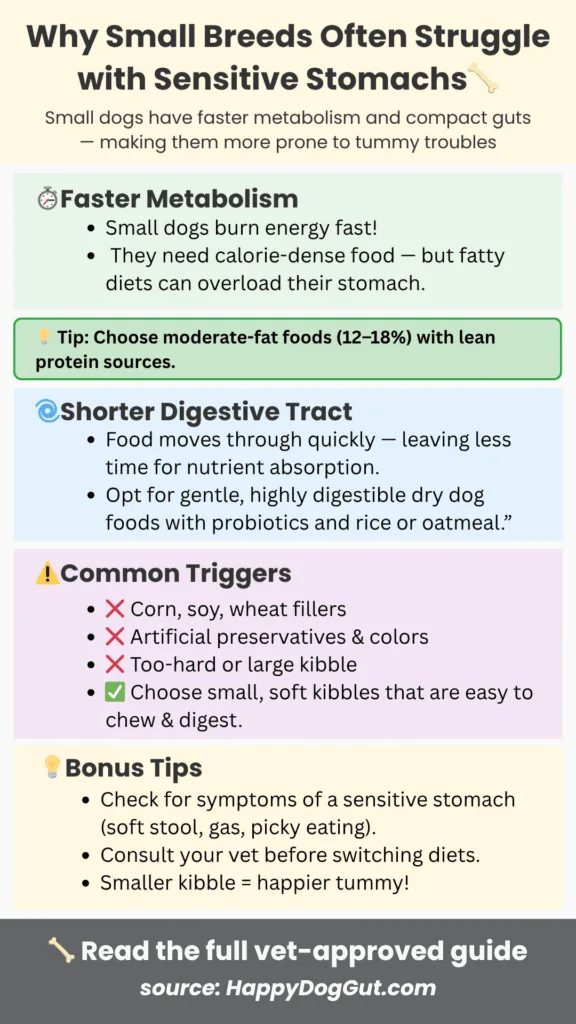
👉 If your dog shows recurring digestive issues, check these common symptoms of sensitive stomachs in dogs before changing diets.
👉 Pro Tip: When choosing the best dry dog foods for sensitive stomachs in small breeds, always check the kibble size. Smaller, softer pieces are easier to chew and digest — helping prevent bloating and encouraging better nutrient absorption.
How to Evaluate a Dry Food for a Sensitive Stomach (Small Breed)
Not every bag labeled “sensitive stomach” truly supports your small dog’s digestive health. Many commercial foods use buzzwords but still include harsh fillers or difficult-to-digest proteins. Before choosing a brand, here’s how to evaluate what really qualifies as one of the best dry dog foods for sensitive stomachs in small breeds:
🥩 Ingredient Quality & Simplicity
Start with the ingredient list — it tells you everything you need to know about quality.
✅ What to look for:
- Real animal protein (chicken, salmon, turkey, or lamb) listed as the first ingredient
- Limited-ingredient or single-protein formulas to minimize irritation. For dogs that react to store-bought options, homemade food for dogs with sensitive stomachs can offer full ingredient control and better digestion.
- Wholesome grains like oatmeal or brown rice that provide gentle fiber
- Nutrition & Safety Always ensure your chosen brand meets AAFCO nutrient standards for balanced nutrition and safety.
🚫 Avoid:
- Fillers such as corn, soy, or wheat
- By-product meals, artificial colors, and flavors
- Harsh preservatives like BHA or BHT
👉 Simplifying your dog’s diet helps their gut microbiome rebalance naturally, reducing bloating and improving stool quality.
🐕 Fat Level & Digestibility
Small dogs need energy-dense food — but not too fatty. Aim for 12–18% fat content, enough to sustain metabolism without causing stomach upset.
Digestibility improves when food includes:
- Natural prebiotics and probiotics for balanced gut bacteria
- Easily digestible fibers like pumpkin, oats, or brown rice
- Added omega-3 fatty acids for skin, coat, and inflammation support
💡 If your dog experiences gas or loose stools, try a kibble with live probiotic cultures (e.g., Bacillus coagulans). It helps stabilize digestion and reduces post-meal discomfort.
🍖 Kibble Size & Processing
Kibble size matters more than you think — especially for toy and small breeds.
- Look for small, bite-sized kibble made specifically for small jaws.
- Gently processed or air-dried foods retain nutrients better and are less harsh on digestion compared to heat-extruded commercial options.
- Avoid overly hard or large kibble, which can cause gulping, air swallowing, and stomach distress.
🌿 Added Gut-Support Ingredients
The best dry dog foods for sensitive stomachs in small breeds often include natural digestive enhancers to keep your dog’s gut happy:
- Pumpkin – adds soluble fiber and firms up stool consistency
- Prebiotics – feed healthy gut bacteria for long-term balance
- Probiotics – replenish good bacteria after stress or antibiotics
- Slippery elm bark – soothes inflammation and supports intestinal lining
These ingredients work synergistically to improve digestion, enhance nutrient absorption, and maintain a healthy microbiome in small dogs.
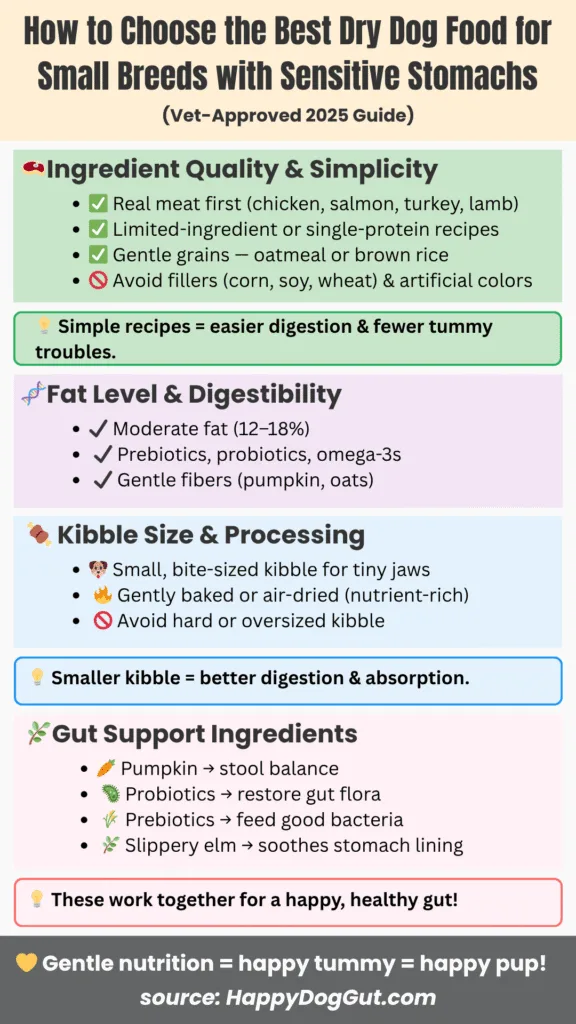
Top 5 Dry Dog Foods for Small Breeds with Sensitive Stomachs (2025 Picks)
After analyzing vet reviews, ingredient lists, and customer satisfaction data, here are five reliable choices for 2025.
1️⃣ Purina Pro Plan Sensitive Skin & Stomach Small Breed
Main Protein: Salmon
Why It Works: This formula uses real salmon and oatmeal—both gentle on small stomachs. It’s enriched with prebiotic fiber and sunflower oil for skin and coat health.
Pros:
- Rich in omega-6 and antioxidants
- Small kibble size
- No artificial colors or flavors
Cons:
- Slightly higher price point
Best For: Toy breeds like Yorkies, Maltese, and Pomeranians.
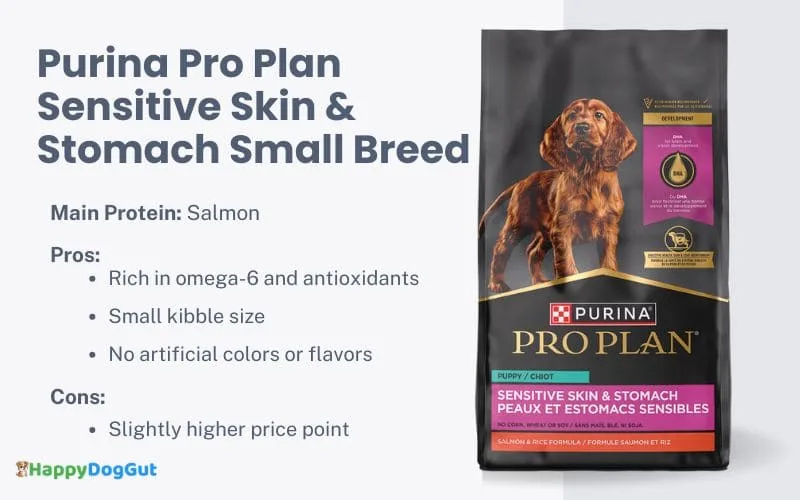
2️⃣ Hill’s Science Diet Sensitive Stomach & Skin Small & Mini
Main Protein: Chicken
Why It Works: Veterinarian-recommended and backed by science, it contains prebiotic fiber and vitamin E to support both digestion and skin health.
Pros:
- Clinically proven antioxidants
- Gentle chicken recipe
- Trusted by vets worldwide
Cons:
- Some dogs may need transition time
Best For: Miniature breeds with recurring digestive upsets.
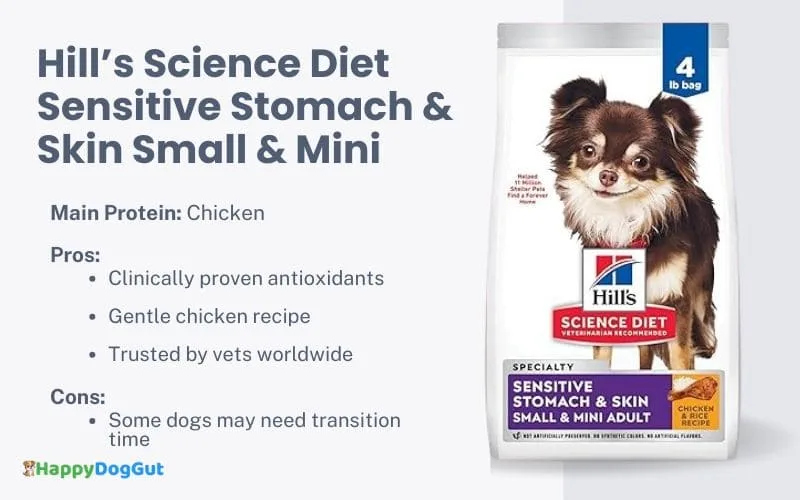
3️⃣ Royal Canin Small Digestive Care Dry Food
Main Protein: Chicken meal
Why It Works: Tailor-made kibble size and optimized fat-to-protein ratio improve stool quality.
Pros:
- Designed specifically for small digestive systems
- Supports balanced gut microbiome
Cons:
- Premium pricing
Best For: Small dogs prone to chronic soft stool or flatulence.
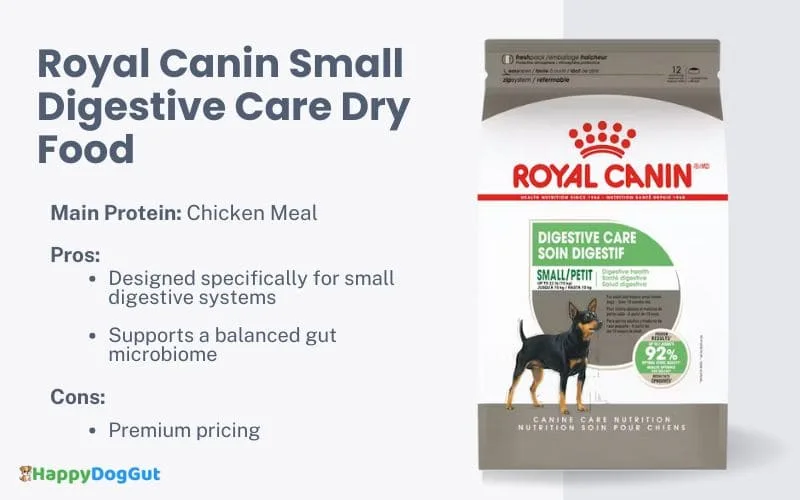
4️⃣ Wellness CORE Small Breed Grain-Free
Main Protein: Turkey & chicken
Why It Works: High protein but balanced with gut-friendly ingredients like flaxseed and chicory root.
Pros:
- Grain-free
- High in digestible protein
- Natural ingredients only
Cons:
- Can be rich for dogs that don’t tolerate high protein
Best For: Active small dogs who thrive on grain-free diets.
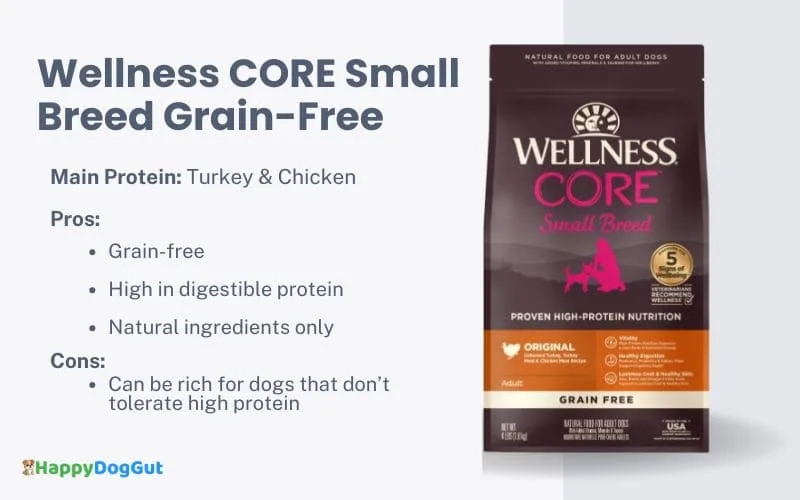
5️⃣ Blue Buffalo Life Protection Small Breed Sensitive Stomach
Main Protein: Chicken
Why It Works: Balanced carbs from brown rice and oatmeal, with probiotics for gentle digestion.
Pros:
- Wholesome grains
- Omega 3 & 6 blend
- Affordable option
Cons:
- Slightly bigger kibble for toy breeds
Best For: Everyday feeding with steady digestion and energy.
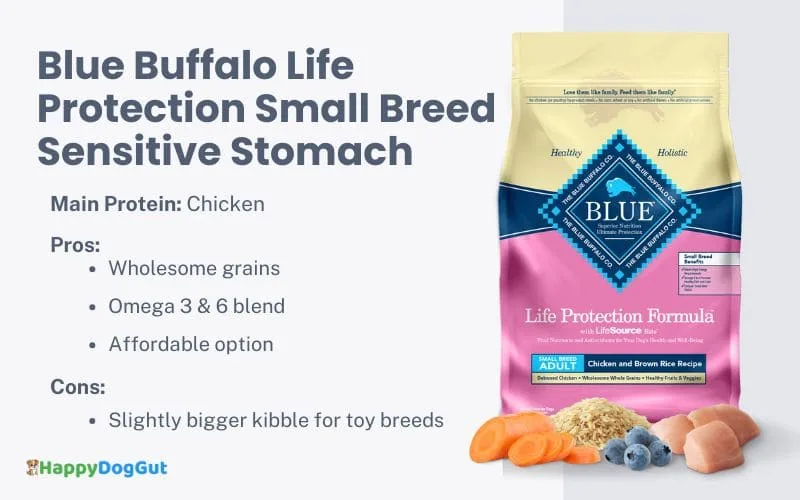
How to Transition Dry Food for Small Breeds Safely
Even the best dry dog foods for sensitive stomachs in small breeds can cause tummy troubles if you switch too quickly. Small dogs have sensitive digestive systems that need time to adapt to new ingredients, protein sources, and fat levels.
To protect your dog’s gut health, follow this vet-recommended 9–11 day transition plan:
- Days 1–4: 25% new food + 75% old food
- Days 5–7: 50% new + 50% old
- Days 8–10: 75% new + 25% old
- Day 11: 100% new food
This gradual change allows your dog’s digestive enzymes and gut bacteria to adjust, reducing the risk of diarrhea, gas, or food refusal.
👉 Pro tip: Mix in a spoonful of plain pumpkin puree or a probiotic supplement during the transition. Both support smoother digestion and help maintain stool consistency.
Avoid changing both your dog’s food and treats at the same time — too many new ingredients can overwhelm the gut.
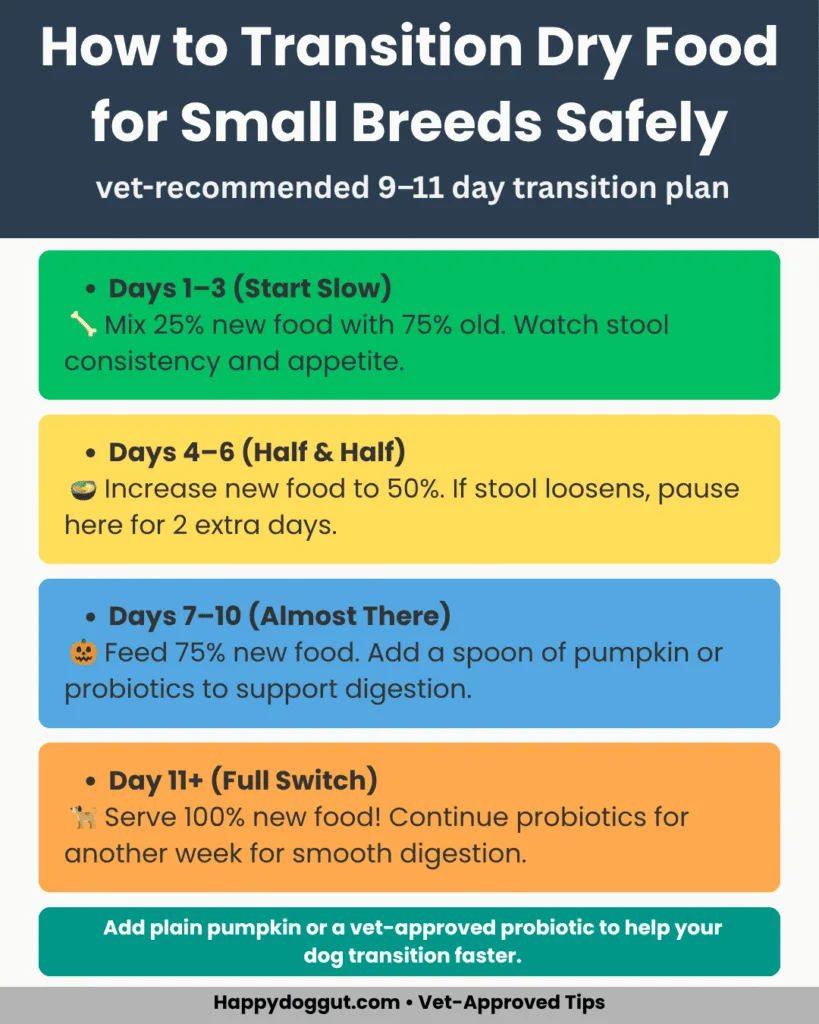
If you’re unsure about timing or your dog shows signs of digestive upset during the switch, check out our complete guide — Dog Food Transition Guide: How to Switch Without Stomach Upset — for step-by-step instructions and vet-approved tips.
Common Mistakes to Avoid with Dry Food for Sensitive Stomachs
Even if you choose one of the best dry dog foods for sensitive stomachs in small breeds, small missteps in feeding habits can undo the benefits. Here are the most common mistakes pet parents make — and how to avoid them:
1. Switching Diets Too Fast
Your dog’s gut bacteria need time to adapt to new ingredients. Rapid changes can cause gas, diarrhea, or refusal to eat. Always follow a slow transition plan (like the 9–11 day schedule above) to keep digestion smooth.
2. Mixing Too Many Proteins
Combining chicken, beef, fish, or lamb in one diet can confuse your dog’s system and trigger sensitivities. Stick to one clean protein source—for example, salmon or turkey—and monitor your dog’s response.
3. Overfeeding
Small breeds have tiny stomachs and fast metabolisms. Overfeeding—even by a small margin—can overwhelm digestion and lead to bloating or loose stools. Follow the portion guides on the bag or your vet’s recommendations.
4. Ignoring Hydration
Dry kibble needs moisture to digest properly. Always ensure fresh, clean water is available at all times. Some small dogs also benefit from adding a spoonful of warm water or bone broth to soften their kibble.
5. Poor Kibble Storage
Nutrients and fats in dry food can break down when exposed to air or heat. Store kibble in its original bag, tightly sealed inside an airtight container, and keep it in a cool, dry place. Freshness directly impacts digestibility and taste.
💡 Pro Tip: Once you open a bag of dry food, aim to use it within 4–6 weeks to preserve freshness and prevent stomach irritation from stale kibble.
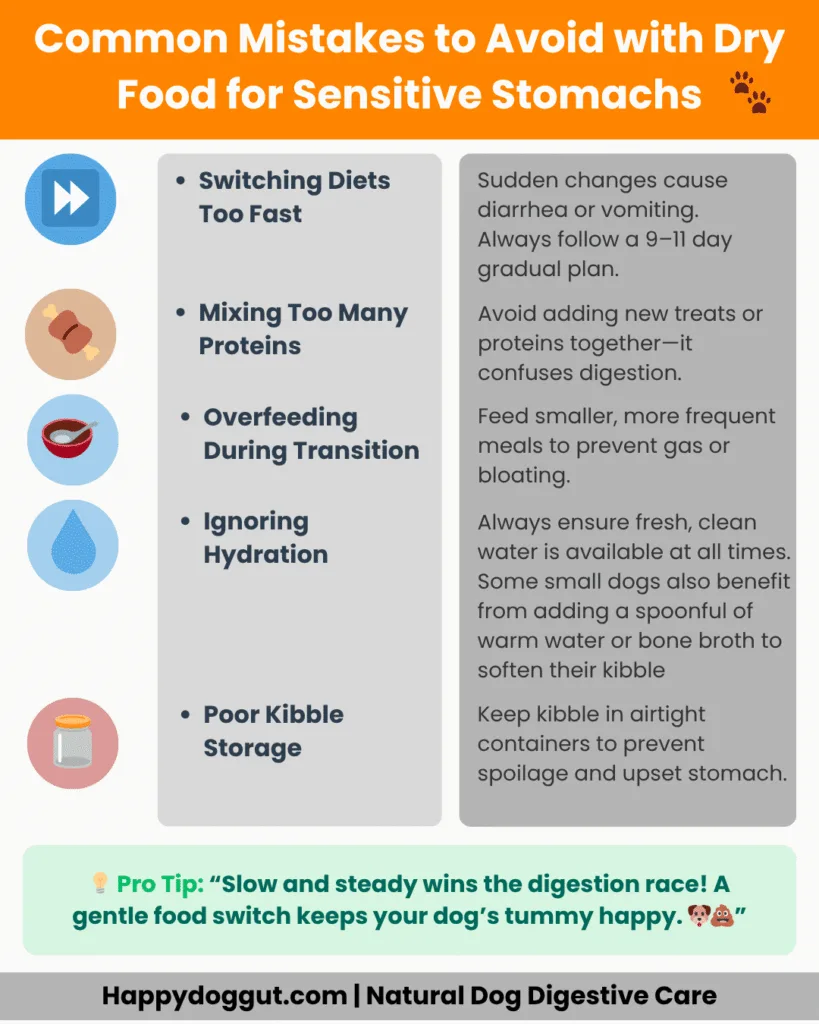
When Dry Food Isn’t Enough — What to Do Next
Sometimes, even the best dry dog foods for sensitive stomachs in small breeds aren’t enough to fully calm your pup’s digestion. If your dog still experiences loose stools, gas, or frequent tummy upsets, don’t worry — you have several smart next steps:
1. Try Limited Ingredient Diets (LID)
Choose foods with just one animal protein and one gentle carbohydrate (like salmon and sweet potato). This helps eliminate potential irritants and makes it easier to pinpoint the trigger.
2. Mix in Wet Food or Toppers for Hydration
Dry kibble alone can be tough on ultra-sensitive tummies. Add a few spoonfuls of wet food, bone broth, or gentle toppers to boost moisture and improve digestibility. Look for options made specifically for small breeds or digestive health.
3. Consider Hypoallergenic or Prescription Diets
If symptoms persist, your vet may suggest a hydrolyzed protein diet or a veterinary-exclusive sensitive stomach formula. These diets are designed for dogs with chronic food sensitivities or enzyme deficiencies.
4. Support Gut Health with Probiotics
Many small dogs benefit from daily probiotic supplements to restore healthy gut flora and improve stool consistency.
Still confused about which type suits your small breed? Learn more about grain-free vs grain-inclusive diets to choose wisely.
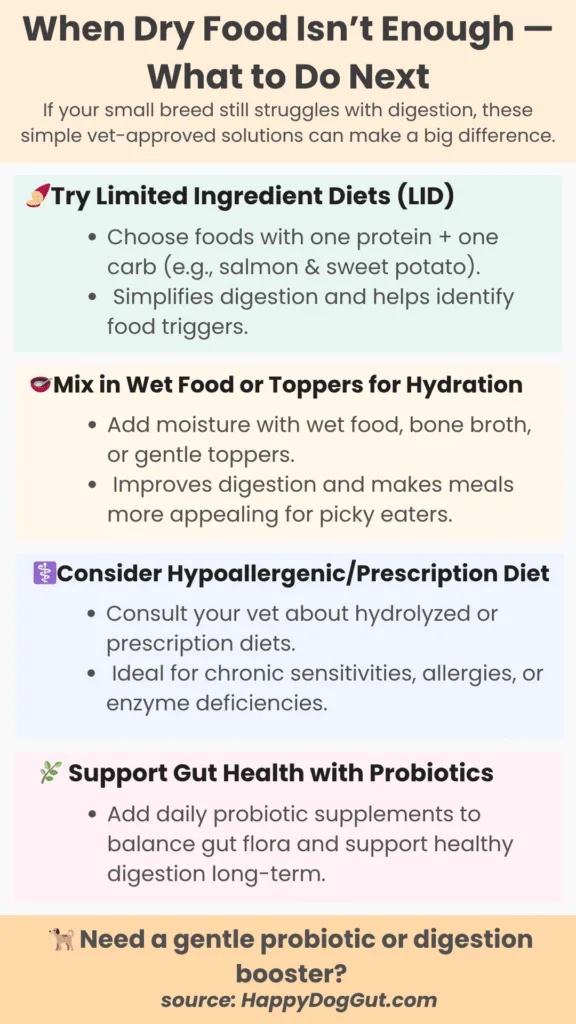
FAQs About Best Dry Dog Foods in Small Breeds
Q1. Is dry kibble bad for small dogs with sensitive stomachs?
Not at all — as long as you choose high-quality, highly digestible kibble made specifically for small breeds. Look for real meat proteins, gentle carbs like oatmeal or rice, and added probiotics to keep your pup’s gut happy. Avoid fillers or artificial colors that can cause irritation.
Q2. How long should I test a new food before judging results?
Give any new diet at least 2–3 weeks to show noticeable improvements in digestion, stool quality, and energy levels. Avoid switching too quickly — small dogs with sensitive stomachs need time to adjust to new proteins and ingredients.
Q3. Can I mix wet and dry food?
Yes — combining wet and dry food is great for small breeds. It adds moisture, flavor, and easier digestion, especially for dogs that don’t drink much water. Start by mixing small portions of wet food and gradually increase over a week to avoid stomach upset.
Q4. What if my dog still has soft stools?
If your dog still has loose stools after switching to the best dry dog food for sensitive stomachs, try adding probiotics, pumpkin puree, or a digestive supplement. Persistent soft stools could signal allergies or intolerances — consult your vet if symptoms last more than a few days.
Q5. Are grain-inclusive dry foods okay for sensitive dogs?
Yes — grains like oatmeal, barley, or rice are actually gentle on many small dogs’ stomachs. Contrary to the grain-free trend, grain-inclusive diets often improve digestion and provide steady energy without upsetting the gut.
Q6. Can I give probiotics with dry kibble?
Absolutely! Probiotics work beautifully alongside dry food, helping to balance gut bacteria and support better nutrient absorption. Choose a veterinarian-recommended canine probiotic and sprinkle it over kibble daily for best results.
Q7. How important is kibble size for small dogs?
Very important. Small breeds need tiny, bite-sized kibble that’s easy to chew and digest. Oversized or dense pieces can cause choking or lead to improper digestion — always pick formulas labeled for “small” or “toy” breeds.
Q8. Should I focus on cost or quality when buying food?
Always prioritize quality over price. Cheap kibble often uses low-grade fillers and artificial additives that can irritate your dog’s stomach. Investing in premium, vet-approved dry food ensures better digestion, fewer vet visits, and long-term health.
Final Thoughts & My Recommendation
Small breeds with sensitive stomachs need food that’s gentle, balanced, and easy to digest — not just tasty. Choosing the best dry dog foods for sensitive stomachs in small breeds can truly transform your dog’s comfort, coat health, and energy levels.
If you want a vet-approved, everyday option, Hill’s Science Diet Small & Mini Sensitive Stomach & Skin remains one of the most trusted choices. It offers consistent digestion support with quality ingredients and prebiotics for gut balance.
For dogs needing extra omega-rich nourishment and a shiny coat, Purina Pro Plan Sensitive Skin & Stomach Small Breed is a fantastic alternative — designed specifically for small dogs with delicate tummies.

👉 If bloating or gas continues, try gentle remedies from our natural upset stomach guide for dogs.
👉 Check out the Best Probiotics for Dogs with Sensitive Stomachs — a complete guide to support digestion while changing foods.
Does your pup have a favorite food that worked wonders for their stomach? Share your experience in the comments — your story might help another dog parent make the right choice!
Hi, I’m Maddy, the writer behind HappyDogGut.com.
I’m passionate about helping dog parents understand gut health, sensitive stomachs, and natural nutrition for dogs.
Every article I create is vet-approved, research-backed, and experience-driven, so your pup can enjoy a healthier, happier gut.
Happy gut = happy dog!
All content on Happy Dog Gut follows our Editorial Policy.




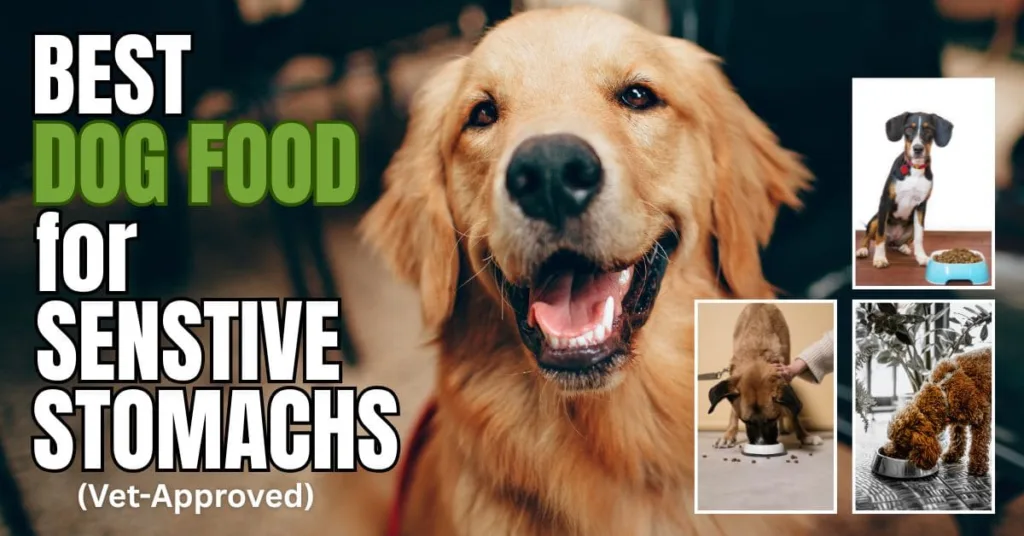

Pingback: Homemade Dog Food for Sensitive Stomachs | Vet-Approved Recipes 2025